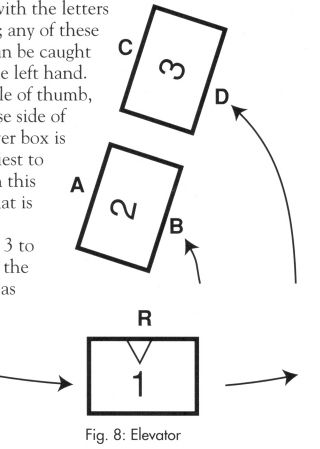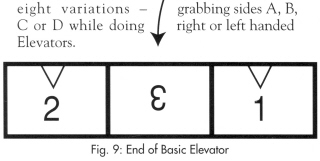|
Elevators are a type of trick that I discovered by combining the End Out with the Tumble. As a reminder, let's look at these tricks briefly. Fig. 7 shows a right handed End Out where all three boxes are released, R reaches across for 1 and carries it back to the right side. L then grabs 2, and 3 is pinned in the middle. The Tumble in Fig. 5 is like a Take Out, but 3 turns 180 degrees before being pinned in the middle.
You
don't need to do A
to 0; any of these
As
a rule of thumb, the close side
of
Next try a right handed Elevator where L grabs B. Now you need to reach across with the left hand to grab the far side of 2. To grab C or D, you'll need more speed because you need to pull it down to pin 2, which is closer to the floor. Now you have eight variations - grabbing sides A, B, C or D while doing right or left handed Elevators.
When
you get comfortable with all four variations with both the right and
left hands, try this exercise: First do the right handed Elevator
where L grabs side A, then the same trick reversed for the left
hand, next the right handed Elevator where L grabs B, then left
handed R grabs B, right handed L grabs C, left handed R grabs C,
right handed L grabs D, left handed R grabs D. The goal is to do all
eight tricks without stopping in between to straighten them out but
instead to correct any misalignment from one trick as you do the
next one.
Now
some variations on Elevators. Again, release all three boxes as in
Fig. 6, but now grab side B with your right hand and L grabs C. Now
the box left in the middle is the one closest to the floor - you
need to drop down fast to pin it.
Also
you can start with a basic Elevator but
There are also many variations where you start an Elevator from Home position then end in one of the balances of one box on top of another or to catch the boxes in a sideways position - but I'll save those for a later article! Generally speaking, Elevators are a great universal transition trick because all three boxes are released and are rotating.
The
End Flip A
variation of the End Turn for some of you advanced boxers is the End
Flip. Like the End Turn, one of the end boxes turns 180 degrees
before returning to Home position, but the hand that flips the box
stays in place. Start with just one box and practice 180-degree
flips (in both directions for all three axes) while keeping your
hand on top in the standard position. You won't be throwing it up
like a juggling prop but as always use your legs to lift it (along
with everything else above your waist) and your hand stays over it
until the catch.
The
basic X-flip (a flip on the X axis) will turn in the same direction
as an End Turn, but for a reverse spin (CCW in the right hand), move
your index finger to the top edge of the box and push down on the
inside end of the box as you release it. I found this easier than
trying to rotate it with the wrist. Try to keep the face of the box
facing forward as it would be if you were holding all of the boxes.
When you do add the other two boxes, you'll want to try to flip the
end box so that it rises and falls
When
I flip all three at once, I set 2 an inch higher than the others for
more leverage. Then as I flip the end boxes CCW (I do the more
difficult reverse spin with the right hand), I push up with the
right side of 1
Of
course, you can do End Flips in the other two axes - for the easier
Y-flip you'll pull the top edge towards yourself, and for the
challenging Z-flip, spot the boxes from the top for the best view. I
haven't yet flipped all three boxes on three different axes at once,
but you're welcome to try if you're up to the challenge! Permutations Here
is a tool that I used to develop new tricks when no one was around
to teach me, and you can use it to learn tricks no matter
First,
there are six possible orders of three boxes numbered 1, 2 and 3:
123, 132, 213, 231, 312 and 321. These are all of the different ways
that the boxes could end after Take Outs or End Outs. For
example, 132 is the end position after the Take Out shown in Fig. 3;
231 is the End Out in Fig. 7; and 321 is a Double End Out. 123 is a
trick where the boxes end in the same order that they started in,
for example to release the boxes, clap, then grab them again.
Next,
for each of the six orders, there are
These
imply the different End Turns and Middle Flips (in the X axis). Then
when you multiply the six orders by the eight ways to turn some, all
or none of the boxes, you have 48 basic tricks including End Turns,
Take Outs, Tumbles and Elevators.
As
you add in different elements such as the different positions that you
can start from or end in, different directions of rotation, cross
handed tricks, and the more intricate Put-Ons, Fly Overs and Passes,
you can see that the total number of tricks increases geometrically.
I
recommend finding a math textbook that explains how to calculate
permutations more thoroughly than I do here. And a quick tip for any
students who are studying permutations - I got some easy extra credit
in my high school math class by demonstrating permutations with my
boxes.
Now
it's up to you to figure out some new tricks on your own. Start with a
list of all the box tricks that you can already do. Then try changing
tricks by: doing it with your other hand, rotating the boxes the
opposite way, going over the top instead of underneath, and starting
with one hand or both hands in the underneath position. Next start
combining
Now
of all the types of tricks that you can do, try applying each of the
possible orders of the boxes to your ending position - so from your
starting position you will try to get to your end position with the
three boxes in each of the six orders described at the beginning of
this section. To do it you'll need to stretch and I'll be the first to
admit that many of these tricks are just plain ugly. Still, if you
accept the challenge of trying them, you'll become much more versatile
and the tricks that you decide to keep will take less effort.
Please send any questions or comments to Jeff Daymont, Long Beach, CA.
(If
you have any comments or suggestions for Juggler's Workshop, write to
editor Martin Frost; Palo Alto, CA or call, or send email. |


